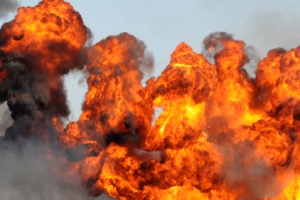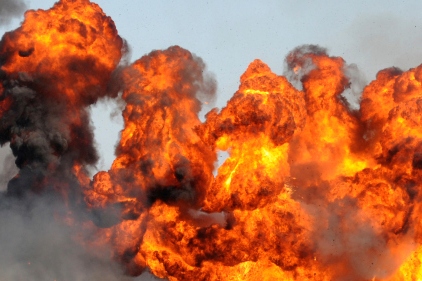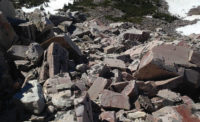 Firefighting operations can inadvertently increase the chance of a combustible dust explosion if they:
Firefighting operations can inadvertently increase the chance of a combustible dust explosion if they:
●Use tactics that cause dust clouds to form or reach the explosible range.
●Use tactics that introduce air, creating an explosible atmosphere.
●Apply incorrect or incompatible extinguishing agents.
●Use equipment or tools that can become an ignition source.
The examples below illustrate these general principles in specific incidents. In some examples, combustible dust fueled the entire event; in others, combustible dust may have contributed to it. In most cases, the initial ignition sequence is unknown or unreported.
South Dakota, 2011: two firefighters killed. According to a National Institute for Occupational Safety and Health (NIOSH) report, a fire occurred in a coal bin that fed a boiler. Firefighters brought it under control at first, but it flared up again. Two firefighters then climbed onto the roof and directed a water hose stream through a hatch. An explosion killed both of them. The explosion may have involved combustible dust, flammable gases, steam, or a combination of these factors.
Wisconsin, 2010: one firefighter killed and eight injured. According to a NIOSH report, foundry workers improperly placed a barrel of hot slag in a recycling dumpster with aluminum shavings, and a fire resulted. The local fire department had not conducted a proper pre-incident survey of the facility and was unaware of the incompatibility of water and burning metals. They attacked the fire with water first, and then foam. Despite making no progress toward extinguishing the fire, as well as visual warnings such as bluish-green flames, the firefighters continued to attack the fire at close range. An explosion killed one of them and injured eight others.
Oregon, 2010: one firefighter injured. News reports indicated that a fire occurred in sawdust waste on a conveyor at a forest products plant. A spark sensor and interlock operated properly and shut down the conveyor. When an access door was opened, the inrush of air triggered an explosion that injured a firefighter.
Unknown location, 2004: two firefighters injured. A National Fire Protection Association (NFPA) report on firefighter injuries described a smoldering fire in ductwork at a furniture manufacturing company. Plant personnel told the fire department that the associated dust collector had been shut down, but it had not. Two firefighters on an aerial lift were injured when they gained access to the duct and an inrush of air caused an explosion.
Maryland, 2005: four firefighters injured. A fire department responded to light smoke coming from a sawdust hopper at a boat manufacturing plant. Two firefighters opened an access door and directed a straight stream of water onto the burning sawdust. A dust cloud discharged from the door, ignited immediately, and injured both firefighters. A second team of firefighters, unable to confer with the injured firefighters, repeated the attack using the same tactics. The same sequence of events recurred and they were also injured.
Ohio, 2003: two firefighters killed, eight injured. According to a NIOSH report, several fire departments were fighting a fire at a lumber company in an oxygen-limiting silo that was filled with wood chips. Firefighters were directing water streams through openings at the base and the top of the silo when there was an explosion. A firefighter on top of the silo and another on an aerial platform were killed). The report cited improper tactics for oxygen-limiting silos as a factor in the outcome.
Source: OSHA publication, “Firefighting Precautions at Facilities with Combustible Dust”




